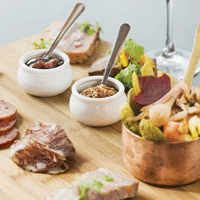Local artisan charcuterie and cheese trump menus across the country
While most youngsters were making peanut butter and jam sandwiches, Michael Steh was making klobasa. “The hand-crank kid,” as he describes his adolescent self, learned how to smoke meat and make sausage under the tutelage of his Slovenian parents on their family farm in Oshawa, Ont., where they also used fresh picks from their orchard to press wine and can fruit. Today, those traditions inspire his award-winning charcuterie at Toronto’s Reds Bistro & Wine Bar, where everyone calls him “Chef.”
Over the past decade, Steh’s charcuterie has appeared on the menus of lauded Toronto establishments he’s worked at, including Canoe and Splendido. Since joining Reds as executive chef four years ago, he’s been showcasing his talents alongside the restaurant’s extensive wine and cheese lists. (There are about 3,000 bottles in the cellar and at least 30 international cheeses to nibble.) On rotation at Reds are more than 30 house-made
charcuterie items, including Steh’s signature traditional Slovenian klobasa — pork sausage with a garlic-pepper punch that he cures for two months — and a chicken liver and foie gras parfait garnished with Madeira gelée. (The chicken livers are sautéed with shallots, garlic and brandy; the foie puréed with cream; and the Madeira steeped with juniper and cinnamon.)
“There is artistry in charcuterie,” says Steh. “I learned the ropes from
people who do things in a very traditional manner. It’s a process used for hundreds of years. When I make salami and sausage, I don’t need to use scales. It’s second nature to me.”
Steh also oversees the diverse and changing cheese list that ranges from milky Italian rocchetta to buttery Quebec sauvagine to sharp Scottish Isle
of Mull cheddar. “The cheese list wasn’t as vast before I came to Reds, but with all of the wines we have, the combination makes sense. Cheese creates character in wine that you wouldn’t find on the nose or palate otherwise,” he says. Cheese and charcuterie plates (small, $15; medium, $20; large, $49) are served with house-made toasted walnut bread and fruit preserves.
Steh’s handiwork has garnered kudos from his peers as well as his customers. On Feb. 2, his suckling-pig porchetta with cured meats took top prize at the 1st Annual Ground Hog Invitational Challenge — a cheeky competition hosted by renowned chef Chris McDonald at Toronto’s Cava, another charcuterie destination. The Spanish-style restaurant serves small sharing plates and McDonald makes his own chorizo, terrine, salami and sausage for platters that change weekly. Cava also serves a selection of Spanish artisan cheese, though McDonald notes his growing interest in Ontario and Quebec cheeses could bring some local additions to the menu.
“Food industry people have become interested in lost culinary arts like making cheese and curing meats,” says McDonald. “There is a lot of verbal tradition in it, and you have to talk to people about family recipes. You have to forage for a teacher.” Once, when McDonald was out buying sausage casing, he met an Italian man who invited him back to his house, where the two spent a Sunday afternoon drinking homemade wine and swapping salami secrets.
Canada’s widely multicultural demographics make it a market basket of traditional ethnic culinary knowledge. Alan Voves, executive chef for Toronto-based chain Alice Fazooli’s, says even visiting Italians approve of the Canadian prosciutto he uses on his antipasto platter and pizzas. Pingue prosciutto is no secret, though — it’s the star product of Niagara Falls, Ont.-based Niagara Food Specialties, run by brothers Fernando and Mario Pingue. They use a method handed down by their father, an Italian immigrant, and have apprenticed in Italy, where their relatives have a small meat business. “I could import the product, but I don’t need to. I get local prosciutto made the same way as it is in Italy,” Voves says. “Artisans put their heart and soul into their work and the result is simply a much better quality product.” Voves also sources fresh mozzarella for his caprese salad from Hamilton, Ont.-based Salerno Dairy Products.
In addition to creating beautiful local food, Canadian artisan producers are innovators. To wit, Ruth Klahsen, owner of Stratford Ont.-based Monforte Dairy. The veteran chef-cum-cheesemaker launched a community shared agriculture (CSA) program last year to raise funds to build a new dairy. CSA subscribers prepay for cheese that will be distributed to them over the next five years — a pivotal business model that will, hopefully, be a catalyst for more micro-producers. So far, contributions have surpassed $400,000, the dairy is built and there are plans for a cheesemaking school, set to run from January to March, 2011, when there’s a production break scheduled.
“I love making cheese, but my main role is to help farmers,” Klahsen says. “We have to learn how to live sustainably. Chefs have always been able to source amazing products, but it’s important for them to be able to get them locally.” Monforte makes dozens of sheep’s and goat’s milk cheeses, like its Piacere, a soft sheep’s milk cheese rubbed with rosemary, summer savoury, juniper and chilies, and covered with wild blue mould.
Artisans across the country are bringing delicious terroir products to the cheeseboard. Gurth Pretty, chairman of the Canadian Cheese Association and author of The Definitive Guide to Canadian Artisanal and Fine Cheese, is a fromage guru with favourites in every province, such as Dragon’s Breath, a Nova Scotia blue cheese, and Old Grizzly, an aged gouda from Alberta’s Sylvan Star Cheese. “With artisanal cheeses, it’s important for chefs to keep in mind that products will vary from season to season,” says Pretty. “The flavour is influenced by what the animals eat and the appearance can be affected by environmental factors like humidity.”
Some chefs are putting a Canadian spin on charcuterie, too. At Montreal’s DNA restaurant, executive chef Derek Dammann makes “seal-ami.” He explains that seal meat is, in fact, sustainable and quite tasty. “Seal is like venison meets chicken liver; not at all fishy. It’s very lean, so I combine it with pork to get a good consistency,” Dammann says. He also adds wild fennel, white wine, garlic and pepper into the mix. DNA’s charcuterie plate ($20) changes often and allows customers to taste 12 to 15 house-made delicacies, including sausage, terrine and parfait. “Our tasting plate is very popular,” he says. “People respect the work that goes into the food and they appreciate that it’s all made with Quebec products.”
Of course, Montrealers aren’t the only ones going whole hog for charcuterie. In March 2009, Joe Chaput and his wife, Allison Spurrell, opened Au Petit Chavignol — a much-praised cheese and meat haunt in Vancouver. The couple, alongside Spurrell’s mother, have run Les Amis du Fromage, a successful cheese shop in the city, for the past 20 years. The restaurant features dozens of the hundreds of cheeses available at Les Amis and the main menu includes gourmet mac-and-cheese renditions, such as portobello mushroom and gruyère, along with fondue, raclette and pomme frites. Artisan creations like Dutch goat gouda with nettles and garlic appear on the cheese and charcuterie list, as do house-made duck rillettes and pâté, plus much-sought-after Spanish imports such as serrano ham and ibérico lomo.
Everything is available à la carte, but the grand tasting platters are the biggest hits. A small serving ($33) contains three meats and three cheeses and a large ($50) has five of each. Both plates come with a selection of accompaniments, like local Strathcona crab apple and herb jelly and Fraser Valley wildflower honeycomb. “People love seeing a big leg of ibérico ham up on the stand. We slice it to order,” Chaput says. “Sharing food is fun and casual and our customers like that. It’s affordable, too.”
In the city’s Gastown neighbourhood, a triad of restaurants is a testament to the charcuterie craze. Sean Heather owns The Irish Heather Pub, Salt Tasting Room and Judas Goat Taberna — all serving salty pig plates and all located within the same block. He credits much of his restaurants’ success to his incredible local suppliers. “There are people in Vancouver — Serbians, Italians, Germans — who are making charcuterie the way they learned from their grandparents. I sought them out and was blown away by the quality. It rivals anything being done in New York or anywhere I’ve been,” Heather says.
Executive chef Lee Humphries also contributes house-made dishes to the menus, one of his favourites being a lamb, savoy cabbage and white truffle oil terrine. “The fine-dining seven course menu is virtually extinct,” he says. “It’s more social and inviting to share 25 different items.” At Salt, the always changing tastes of the day are written on a large chalkboard and customers build their ultimate plate, combining meats, cheeses and condiments. The idea is that they’ll never have the same experience twice. “Food is about entertainment as much as it is about sustenance,” says Heather. And it’s with that attitude the clever restaurateur has made a silk purse out of a sow’s ear.




















